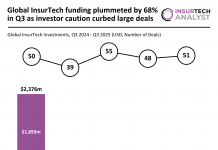As AI becomes more widely used across industries, insurance is lagging behind. Akur8 believes this could be down to the need for transparency.
Akur8 has released a new white paper, “AI for Good vs. AI made evil: why ethical AI should be a top priority for insurers.” In the document, the InsurTech explores how transparent AI can drive adoption in insurance by making firms more confident in the results.
A report from CapGemini Research Institute claims that 13% of insurance firms have experienced reductions in operation costs and 11% witnessed an increase in revenue per customer thanks to AI. Despite the positive results, insurance is behind other industries in adoption, with just 6% of insurers having deployed the technology at scale. This is compared to industries like life science, retail and government, which have adoption rates of 27%, 21% and 9%, respectively.
In its white paper, Akur9 explains that one of the reasons insurance has lagged behind is down to a “lack of incentives.” It stated that the overall stability of the insurance competitive landscape and advantageous interest rates have fostered attractive conditions. However, this is changing and GAFAs and InsurTechs are posing more of a threat to competitiveness due to lower interest.
The second issue is that there are perceived risks of using AI. This is down to blackbox solutions that offer no control and unacceptable biases. These types of systems cannot be used for processes like pricing, where full transparency is required, and can have hefty financial impacts if misused.
It said, “The notion of Transparency applied to AI is actually at the core of governing principles for ethical AI. “Ethics guidelines for trustworthy AI” from the European Commission established a list of 7 principles for governing the ethical issues arising from AI system use. Principle number 4 is “Transparency”. AI systems should be based upon the principle of explainability, and should encompass transparency and communication of the elements involved, namely the data, the system and business models.”
Regulatory scrutiny is growing around the world, with an emphasis in ensuring they are fair and transparent. The US National Association of Insurance Commissioners has even established a committee aimed at AI in insurance and ensuring the technology will be fair, ethical, accountable and safe.
When building an AI platform, some might seek to make it explainable, but that is not the same as being transparent. The white paper claims that explainable AI can be explained, but only in hindsight. It essentially lets the company retrace the steps of the thought and justify the answer.
However, it does not provide a transparent understanding of the train of thought which led to the decision.
The white paper said, “Transparent AI is a breakthrough and the safest way for insurers to use AI-powered solutions at scale, in production. It is a win-win for both insurers and consumers, on the one side bringing substantial performance and speed, generating value for insurers that is passed on to their clients; on the other side protecting customers, by preventing biases and guaranteeing fairness of treatment. As a result, it can deliver tremendous competitive advantage to insurers that will be amongst the first to harness it.”
Read the full white paper here.
Copyright © 2021 FinTech Global










